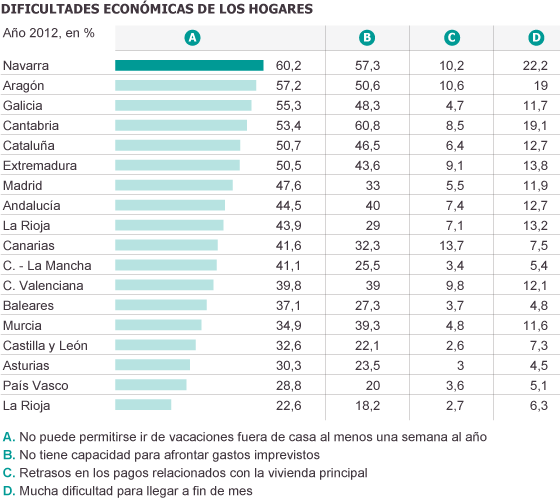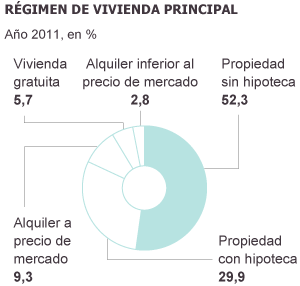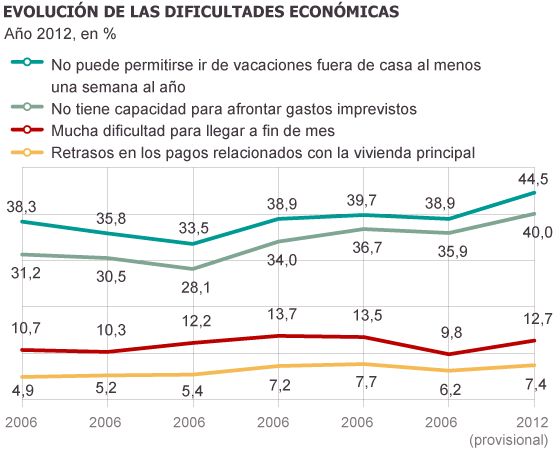スペインの2012年の国立統計院(INE.Instituto Nacional de Estadistica)の生活状況の調査の暫定結果によると、月末が金銭的に苦しい家族は2'9%増加して12'7%で、1週間の外出の夏休みが取れない家族は5'6%増加して44'5%で、急の出費ができない家族は4'1%増加して40%に。
La mitad de las familias españolas no pueden ir de vacaciones fuera de casa
Los ingresos medios de los hogares bajan casi un 2%
El 12,7% tiene dificultades para llegar a fin de mes
El País Madrid 22 OCT 2012 - 15:55 CET
Half of Spanish families can not go on vacation away from home
The average household income down nearly 2%
The 12.7% have difficulties making ends meet
The Country Madrid 22 OCT 2012 - 15:55 CET
More and more families are struggling to make ends meet as a result of the crisis. Specifically, according to provisional results of the survey of living conditions of the National Statistics Institute (INE), this year the situation is declared in 12.7% of Spanish households, a percentage that exceeds by 2.9 points to registered in 2011. In addition, 44.5% of households can not afford to go on vacation away from home at least one week a year, up 5.6%, and 40% of households do not have capacity to handle unforeseen expenses, compared to 35.9% in 2011. 7.4% had late payments related to the main housing (mortgage or rent, gas bills, electricity, community), 1.2 points higher than the previous year.
Source: INE / The Country
These difficulties have to do with the progressive reduction of income that Spanish households have suffered in recent years. According to the INE study, families were admitted an average of 24,609 euros in 2011, representing a decrease of 1.9% over the previous year. It also lowered the average income per person, up to 9321 euros, 1.3% less.
However, while average incomes have declined, the percentage of population below the poverty line is reduced. In 2012 this rate stood at 21.1% of the resident population in Spain, compared with 21.8% in 2011. The explanation lies in reducing this percentage among those over 65, who has risen from 21.7% in 2010 to 16.9% in 2012. In contrast, the percentage of population below the poverty line increased in people between 16 and 64 years, from 19.4% in 2010 to 21.0% in 2012.
By region, the Canary Islands (33.8%), Extremadura (31.9%) and Andalusia (31.7%) are most at risk of poverty rate recorded in 2011, while Navarre (8.8%), Asturias (9.9%) and Basque Country (10.8%) were located at the end of the table.
The risk of poverty threshold is calculated annually based on the distribution of income in the previous year. Following the criteria recommended by Eurostat, this threshold is set at 60% of median income per consumption unit of people. Therefore, increases or decreases to the extent that it does median income.
Source: INE / The Country
Different thresholds are obtained Poverty risk by household size and the age of its members. For households of two adults and two children under the threshold is 15 445 per year in 2012, 2% below that calculated for 2011. Per person, the threshold is reduced to 7355 euros.
The fact consider when calculating the value of the dwelling in which the household resides, when it is owned or granted free of charge, making the risk of poverty rate decreased in all age groups. That is why the population over 65, who owns a greater proportion of their home, has the lowest percentage of poverty risk (8.5% in 2012).
Another fact that emerges from the INE survey is that 52.3% of households had home ownership without a mortgage in 2011, while 29.9% are paying a mortgage and 9.3% live in rental houses.



0 件のコメント:
コメントを投稿